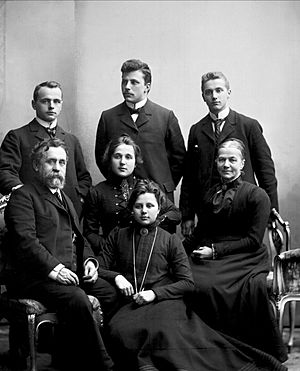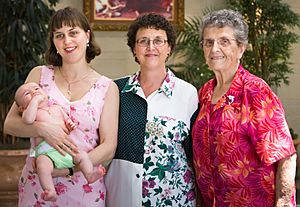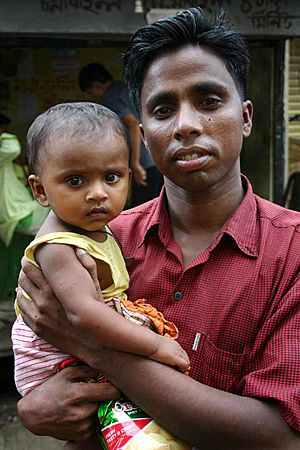Family facts for kids
A family is a group of people who are usually related to each other. They often live together, share their resources, and support one another. Family members can be related by genetics (like brothers and sisters) or by law (like through marriage). In many cultures, family members share the same last name.
A family is often seen as the most basic and important unit of society.
Contents
Who is in a Family?
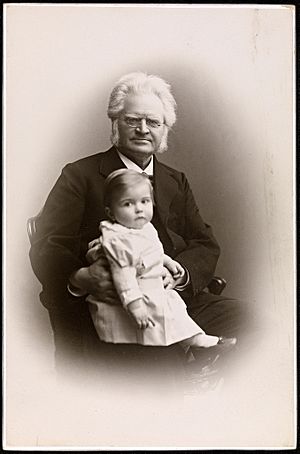
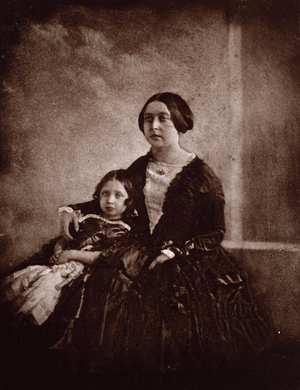
In many parts of the world, especially Western countries, people use common terms to describe family members. These terms help us understand how everyone is related.
Here are some common family roles:
- Father: A male parent.
- Mother: A female parent.
- Son: A male child of a parent.
- Daughter: A female child of a parent.
- Brother: A male sibling (someone who shares a parent).
- Sister: A female sibling.
- Husband: A male spouse (partner in marriage).
- Wife: A female spouse.
Extended Family Members
Beyond the immediate family, there are other relatives:
- Grandfather: The father of your mother or father.
- Grandmother: The mother of your mother or father.
- Uncle: Your parent's brother, or the husband of your parent's sister.
- Aunt: Your parent's sister, or the wife of your parent's brother.
- Nephew: Your sibling's son.
- Niece: Your sibling's daughter.
- Cousins: Children of your aunts or uncles.
Sometimes, families can be a bit more complicated. If children share only one parent, they are called "half-brothers" or "half-sisters." When a parent remarries, their new spouse becomes a "stepparent" (stepmother or stepfather). The children of the new spouse become "stepbrothers" or "stepsisters."
Families can also include adopted children, who are considered full members of the family, just like children born into it. Sometimes, close friends of parents are called "aunt" or "uncle" even if they are not related by blood. This is called fictive kinship.
When people marry, their spouse's family members become their "in-laws." For example, your spouse's mother is your mother-in-law.
How Families Are Traced
Different cultures trace family connections in different ways.
Patrilineal Families
Patrilineality means that family membership and inheritance are passed down through the father's side. This is also called the "male line." In this system, your family name and important family ties come from your father, his father, and so on.
Matrilineal Families
Matrilineality is when family membership and important connections are traced through the mother's side. This is sometimes called the "mother line." In this system, your family ties come from your mother, her mother, and so on.
Bilateral Families
Bilateral descent means that family membership and connections are traced through both the father's and mother's sides equally. Both sides of the family are important for emotional support and for passing down property or wealth. This system recognizes relatives from both parents' families as equally important.
This type of family system is found in places like West Africa, India, Australia, and Polynesia. It can be helpful for families living in challenging environments because it allows them to rely on relatives from two different family groups spread across a wider area.
Related pages
Images for kids
-
Sauk family photographed by Frank Rinehart in 1899
-
Mennonite siblings, Montana, United States, 1937
-
Settled Sami (Lapplander) family of farmers in Stensele, Västerbotten, Sweden, early 20th century
-
Hispanic family eating a meal.
-
A family from Basankusu, Democratic Republic of the Congo.
-
The family of Finnish statesman J. K. Paasikivi (right) in 1906
See also
 In Spanish: Familia para niños
In Spanish: Familia para niños


